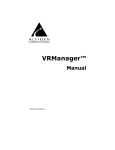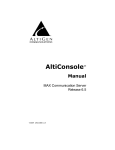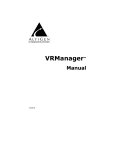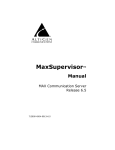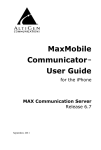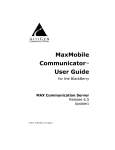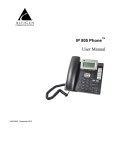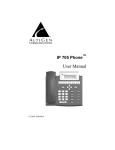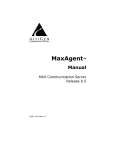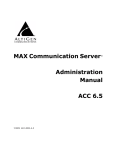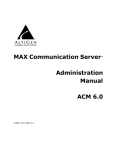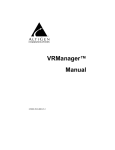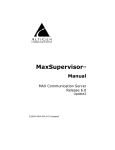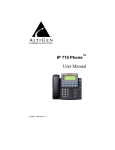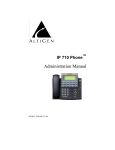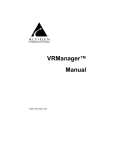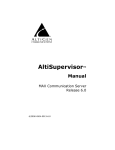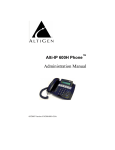Download VR Manager Manual
Transcript
VRManager™ Manual MAX Communication Server Release 6.7 April 2012 WARNING! Toll fraud is committed when individuals unlawfully gain access to customer telecommunication systems. This is a criminal offense. Currently, we do not know of any telecommunications system that is immune to this type of criminal activity. AltiGen Communications, Inc., will not accept liability for any damages, including long distance charges, which result from unauthorized and/or unlawful use. Although AltiGen Communications, Inc., has designed security features into its products, it is your sole responsibility to use the security features and to establish security practices within your company, including training, security awareness, and call auditing. NOTICE While every effort has been made to ensure accuracy, AltiGen Communications, Inc., will not be liable for technical or editorial errors or omissions contained within the documentation. The information contained in this documentation is subject to change without notice. This documentation may be used only in accordance with the terms of the AltiGen Communications, Inc., License Agreement. AltiGen Communications, Inc. 410 East Plumeria Dr. San Jose, CA 95134 Telephone: 888-AltiGen (258-4436) Fax: 408-597-9020 E-mail: [email protected] Web site: www.altigen.com TRADEMARKS MAX Communication Server, MaxAdministrator, MaxCommunicator, MaxAgent, MaxSupervisor, MaxInSight, MaxOutlook, MaxCall, Enterprise Manager, AltiServ, AltiLink, AltiConsole, VRPlayer, Zoomerang, IPTalk, Alti-Mobile Extension, InTouch Dialer, AltiReport, and SuperQ are trademarks or registered trademarks of AltiGen Communications, Inc. All other brand names mentioned are trademarks or registered trademarks of their respective manufacturers. Copyright © AltiGen Communications, Inc. 2012. All rights reserved. Contents CHAPTER 1 Installing VRManager . . . . . . . . . . . . . . . . . . . . . . . . . . . . . . . 1 Requirements . . . . . . . . . . . . . . . . . . . . . . . . . . . . . . . . . . . . . . . . . . 1 Pre-Setup . . . . . . . . . . . . . . . . . . . . . . . . . . . . . . . . . . . . . . . . . . . . . 2 Installing VRManager Service . . . . . . . . . . . . . . . . . . . . . . . . . . . . . 2 Fresh Install. . . . . . . . . . . . . . . . . . . . . . . . . . . . . . . . . . . . . . . . . . 2 Upgrade from Previous Version . . . . . . . . . . . . . . . . . . . . . . . . . . 3 Installing VRManager for a Client . . . . . . . . . . . . . . . . . . . . . . . . . . . 4 Setting Access Privileges . . . . . . . . . . . . . . . . . . . . . . . . . . . . . . . . . 4 CHAPTER 2 Using VRManager Admin . . . . . . . . . . . . . . . . . . . . . . . . . . . . 5 VRM Admin Window . . . . . . . . . . . . . . . . . . . . . . . . . . . . . . . . . . . . . 5 User Page . . . . . . . . . . . . . . . . . . . . . . . . . . . . . . . . . . . . . . . . . . . 5 Adding Users . . . . . . . . . . . . . . . . . . . . . . . . . . . . . . . . . . . . . . 6 Editing User Details . . . . . . . . . . . . . . . . . . . . . . . . . . . . . . . . . 7 Changing the Admin Password . . . . . . . . . . . . . . . . . . . . . . . . 7 Pooling Page . . . . . . . . . . . . . . . . . . . . . . . . . . . . . . . . . . . . . . . . . 7 Storage Page . . . . . . . . . . . . . . . . . . . . . . . . . . . . . . . . . . . . . . . . 8 Log Page . . . . . . . . . . . . . . . . . . . . . . . . . . . . . . . . . . . . . . . . . . . 10 AltiWare ACC or ACM Page . . . . . . . . . . . . . . . . . . . . . . . . . . . . 11 Adding Servers . . . . . . . . . . . . . . . . . . . . . . . . . . . . . . . . . . . . 12 Changing the Centralized Recording Directory . . . . . . . . . . . 13 CHAPTER 3 Using VRManager Client . . . . . . . . . . . . . . . . . . . . . . . . . . . . 15 VRM Client Main Window . . . . . . . . . . . . . . . . . . . . . . . . . . . . . . . . 15 Menu Bar . . . . . . . . . . . . . . . . . . . . . . . . . . . . . . . . . . . . . . . . . . . . 16 Quick Access Toolbar . . . . . . . . . . . . . . . . . . . . . . . . . . . . . . . . . 16 File Menu. . . . . . . . . . . . . . . . . . . . . . . . . . . . . . . . . . . . . . . . . . . 16 Saving Files . . . . . . . . . . . . . . . . . . . . . . . . . . . . . . . . . . . . . . 16 Export to File . . . . . . . . . . . . . . . . . . . . . . . . . . . . . . . . . . . . . 17 Change Password . . . . . . . . . . . . . . . . . . . . . . . . . . . . . . . . . 18 Edit Menu . . . . . . . . . . . . . . . . . . . . . . . . . . . . . . . . . . . . . . . . . . 18 Searching Voice Records . . . . . . . . . . . . . . . . . . . . . . . . . . . . 18 VRManager Manual i Playing Voice Records . . . . . . . . . . . . . . . . . . . . . . . . . . . . . . 19 Displaying Columns . . . . . . . . . . . . . . . . . . . . . . . . . . . . . . . . 20 Sorting . . . . . . . . . . . . . . . . . . . . . . . . . . . . . . . . . . . . . . . . . . 21 Media Player Option . . . . . . . . . . . . . . . . . . . . . . . . . . . . . . . 21 Report Menu . . . . . . . . . . . . . . . . . . . . . . . . . . . . . . . . . . . . . . . . 21 Index . . . . . . . . . . . . . . . . . . . . . . . . . . . . . . . . . . . . . . . . . . . . . . 23 VRManager Manual ii CHAPTER 1 Installing VRManager VRManager performs recorded file management — indexing, converting, tracking, playback, reporting, and other critical functions for call center customers who would like to keep recorded files for administrative, legal, or quality assurance purposes. Requirements Install VRManager on a different system than the one on which the MAXCS ACC/ACM server is installed. If you are upgrading, you can upgrade from VRManager 5.2 and above only. VRManager requires the following: • VRManager License installed at the MAXCS ACC/ACM system. (You can verify the licenses when you run MaxAdministrator by selecting License > License Information.) • MAX Communication Server (MAXCS) ACC/ACM (6.7 or higher) • Pentium IV 2 GHz (minimum) CPU • 40 GB available hard drive disk space • 1 GB RAM • IDE RAID 0-1 (minimum) hard drive • NIC • Microsoft Windows 2003 SP2, Windows 2008, or Windows 2008 R2 • Java 2 Runtime Environment (SE v1.4.2) (VRManager installation program will install this) • MDAC (Microsoft Data Access Components) 2.8 or higher version • Microsoft Internet Explorer 6.0 or later. A minimum installation is sufficient, and Internet Explorer does not have to be the default browser. VRManager Manual 1 Pre-Setup The SQL 2008 Express database is installed with the VRManager Setup program. Before running Setup, please ensure the following. • File and print sharing must be active on your operating system. To verify: 1. In Control Panel, double-click Network Connections. 2. On the Advanced menu, click Advanced Settings. 3. On the Adaptors and Bindings page, ensure that File and Print Sharing for Microsoft Networks is selected. • Make sure that Silently succeed is selected in the local security options named below. 1. In Control Panel, double-click Administrative Tools. 2. Double-click Local Security Policy. 3. Expand Local Policies. 4. Select Security Options. 5. Ensure that the following option in the right pane is set to Silently succeed before installing: On Windows 2003: Devices: Unsigned driver installation behavior. • Problems can occur if you use a Terminal Services or Remote Desktop connection to attempt to install a new instance of SQL 2008 Express. If problems are encountered, restart the VRManager Setup program from the local computer without using Terminal Services or Remote Desktop. Installing VRManager Service To install VRManager service, you will use one of two methods: Fresh install and Upgrade from previous version. Fresh Install If you do a fresh install, the installation program installs SQL 2008 Express and Jservice Loader on your system automatically. 2 VRManager Manual 1. Run the Setup program and follow the instructions as they appear on the screen. 2. In the Custom Setup screen, choose to install Voice Record Manager Service and Voice Record Manager Admin. If you plan to use VRM Client at this system, also select Voice Record Manager Client. Then click Next. After installation, you can run VRManager Admin from Start > Programs > VRManager > VRM Admin. Upgrade from Previous Version To upgrade from VRManager 5.2 or above: 1. Stop the VRM service. 2. Run the Setup program. 3. Follow the installation instructions as they appear on the screen. In the Custom Setup screen, choose to install Voice Record Manager Service and Voice Record Manager Admin. If you plan to use VRManager Client at this system, also select Voice Record Manager Client. VRManager Manual 3 Installing VRManager for a Client To install VRManager for a client system: 1. Run the Setup program and follow the instructions on the screen. 2. In the Custom Setup screen, choose to install Voice Record Manager Client or Voice Record Manager Admin. If you install VR Admin on a client system, some Browse buttons will not appear. After installation, you can run VRManager Client from Start > Programs > VRManager > VRM Admin or VRM Client. Note: If VRManager is run behind a firewall, open TCP port 10040. (VRManager may not work behind NAT.) Setting Access Privileges • The directory of centralized records in the MAXCS ACC/ACM server must be shared fully with the VRManager user. This user not only requires privilege to read/write to the shared folder, but also read/write to the local folder. • The destination of the backup location must be valid and accessible in the local computer or remote computer. The user must have full privilege to read/write to the shared and local folders. • In Windows 2003 Server, the default setting of the OS security is very robust, so caution should be used when setting users’ access privileges. 4 VRManager Manual CHAPTER 2 Using VRManager Admin To run VRManager Admin: 1. Choose Start > Programs > VRManager > VRM Admin. 2. Enter the VRM Server IP address or server name and Password. (The default password is 22222.) 3. Check the Save Password checkbox if you want VRM Admin to remember the password the next time the program runs. 4. Click OK. Note: Each Windows user has his own VRM Admin login setting. VRM Admin Window VRM Admin has five configuration pages: • User • Pooling • Storage • Log • AltiWare ACC/ACM User Page The VRM User page shows the User List for VRManager clients and shows the workgroups, extensions, and systems that the user can query. From this page, an administrator can add, edit, and delete users; limit their queries to certain workgroups, extensions, and systems; change user passwords; and change the VRM Admin password. VRManager Manual 5 Adding Users To add a new VRManager Client user: 1. Click New. Enter a User Name, Password and Password Confirmation. (The account name is not case-sensitive.) 2. Click OK. The new user appears in the User List field. 3. To limit this user’s queries to certain workgroups, extensions, and systems, select the new user and click Edit. Enter the workgroup numbers, the extension numbers, and system IDs. Separate entries with a comma. (To allow the user to query all workgroups or all extensions, leave those text boxes empty.) 6 VRManager Manual Editing User Details To edit a user: 1. Select the user on the User page and click Edit. 2. Make your changes, and click OK. Changing the Admin Password To change the VRM Admin password: 1. Click the Change Admin Password button. 2. Enter the information in the Old Password, New Password and Confirm Password fields, and then click OK. Pooling Page The pooling page lets you set the location of the primary storage directory. Click Browse to select the location. VRM Admin pools the newly recorded files from the MAXCS server, and saves them into the primary storage directory in the .wav format you select here (G.723.1, GSM, PCM). VRManager Manual 7 Note: The Browse button is not available if VRM Admin is running on a different server than VRM Service. Storage Page On the Storage page you can set backup conditions for the storage of voice records. 8 VRManager Manual Select one of the following conditions: • Automatic delete record without backup – VRM Admin will delete records without backing them up. To set additional automatic delete parameters, select any of the following options: Delete records older than x day(s) Delete records when free space below x MB Delete records when free space below x % • Schedule Backup – VRM Admin will automatically back up, then delete records. To specify backup parameters, select any of the following options: Start when free space below x MB Start when free space below x % Schedule – Ffor detailed settings, click Details. Use the drop-down list to select the Schedule Task (Daily/Weekly/Monthly), use the up/down arrows to select the Start Time and to define the Daily Schedule (every x days), Weekly Schedule (any day in every x weeks), or Monthly Schedule (any date in every month), then click Apply. Use the Advanced button to set a Start Date and End Date; or check the Repeat Task checkbox to set up parameters for a continuous schedule, then click OK. VRManager Manual 9 Check the Show multiple schedules checkbox to display and set up more than one schedule. You can add new multiple schedules, then modify them. • Backup Storage – Enter the location for the backup storage, or use Update to select a new location. You can enter a local path or network path. The destination of the backup location must be valid and accessible in the local computer or remote computer. The user must have full privilege to read/write to the shared and local folders. Also, VRManager supports backup to DVD/RW; simply enter the path for the DVD/RW location. Note: The Browse button is not available if VRM Admin is running on a different server than VRM Service. • Execute Now button – Click this button will begin backup of records. When you have finished setting backup parameters, click Apply or OK. Log Page A log file for the VRM server is created each day named “yyyymmdd.log” (for example, 20040404.log). A daily report for the VRM server is also created “yyymmdd.rpt” (for example, 20040404.rpt). The Log window allows an administrator to set the directory paths for VRM log and report. 10 VRManager Manual Note: The Browse buttons are not available if VRM Admin is running on a different server than VRM Service. • Set Log Directory – Use Browse or enter a path to specify where you want log files to be saved; check the Delete the log files older than x days checkbox to delete archived log files. • Set Daily Report Directory – Use Browse or enter a path to specify where you want daily report files to be saved; check the Delete the log files older than x days checkbox to delete archived daily report files. • Send daily report by mail – VRM will send a report When there is a warning or error or Always. Use the Mail Configuration button to configure the recipient’s email address. Click Test to send a test email. Click Apply or OK when finished. AltiWare ACC or ACM Page The AltiWare ACC or ACM page displays the MAXCS ACC or ACM servers and centralized recording directories that VRManager will access. Here, administrators can add or delete MAXCS ACC/ACM servers, and specify the centralized recording directory for the specified MAXCS ACC/ACM server. VRManager Manual 11 Adding Servers To add a new MAXCS ACC/ACM server, do the following: Add servers at the AltiServ system 1. Make sure the Centralized Storage directory is located on the local drive on the AltiServ system. 2. Share the storage directory with Full Control to a domain user or local administrator. Add servers at the VRM Server 1. In the AltiWare ACC or ACM page of VRM Admin, click New. 2. Enter the MAXCS ACC or ACM Server IP Address, Centralized Recording Directory (the Share name of the centralized recording folder), User Name and Password. Then click OK. If the user account belongs to an NT domain, you must enter “NTDOMAIN;username” in 12 VRManager Manual the User Name edit box. If the account is local Administrator, just enter administrator. After adding a new server, VRM Service immediately checks the MAXCS server for the VRManager License. The newly added server is displayed in the MAXCS ACC or ACM Server List field. Note: VRManager starts converting all voice recording data as soon as the MAXCS ACC/ACM Server information is added to the MAXCS ACC or ACM Server List. Changing the Centralized Recording Directory To edit a MAXCS ACC/ACM server’s location for the centralized recording directory, highlight the MAXCS ACC/ACM server in the server list, then input the new location in the Centralized Recording Directory field. VRManager Manual 13 14 VRManager Manual CHAPTER 3 Using VRManager Client To run VRManager Client: 1. Choose Start > Programs > VRManager > VRM Client. 2. Enter the VRM Server IP address or server name, User name and Password. 3. Check the Save Password checkbox to have VRM Client remember the password the next time the program is run. 4. Click OK. Note: Each Windows user has a unique VRM Client login setting. VRM Client Main Window When you start VRM Client, the first window you see is the VRM Client main window. VRManager Manual 15 At the top is a menu bar, and below is a quick-access toolbar. At the bottom is a scroll bar for viewing the display columns. Note: Each Windows user has a uniaue VRM Client display column in the main window. Menu Bar Using the menus, you can perform the following functions: • File – Save As, Export to File, Change Password, Exit • Edit – Search, Play, Display Column, Option • Report – Generate report • Help – VRM Client version information Quick Access Toolbar The toolbar contains buttons that are menu shortcuts. Saves the selected voice recording to a specified location Opens Report Generation dialog box Opens client version information Opens search options Plays the selected voice recording File Menu Saving Files To save a file, click a voice record in the main window to highlight it, and click the Save As button. Or, right-click a voice record and select Save As. 16 VRManager Manual Export to File To export search results to a tab-separated text file (.txt), choose File > Export To File from the main menu,or right-click the search results list and choose Export To File. VRManager Manual 17 Change Password To change your password: 1. Choose File > Change Password from the main menu. 2. Enter the necessary information in the Old Password, New Password and Confirm Password fields, then click OK. The new password applies at the next log in. Edit Menu Searching Voice Records To search voice records, choose Edit > Search or click Search in the toolbar. You can search based on the following conditions: The relational symbols for each condition include: = (equal) < (greater than) > (less than) >= (less than or equal to) <= (greater than or equal to) <> (not equal) 18 VRManager Manual like (look for sub-string) btwn (between) in—searches the results in sets; for example, CallerID “In” “101 AND 102” means CallerID equals 101 or CallerID equals 102. Notes • The date/time format is the same as the system format of the operating system. • Typing “OR” in upper case in the edit box means “or.” • Typing “AND” in upper case in the edit box means “and.” • To leave out a condition, leave the edit box empty. • Only the Comment column will be editable directly from the main view window. Searching for All an Extension’s Voice Records If you query a specified extension’s voice records and in that query you also specify a workgroup, the query results show only the extension’s voice records related to the workgroup. The results do not show non-workgroup voice records. If you want the query results to display all voice records for that extension, leave the WorkGroup field blank. Playing Voice Records To play a voice record, Click a voice record in the main window to highlight it, and then click the Play button. VRManager Manual 19 Note: Deleted voice files do not play. Displaying Columns You can select which columns you want displayed in the main view window. These are the column headers you can select from: • ID • Callee ID • Session ID • Caller ID • DNIS • Workgroup • Length • Date • State – There are three states that a record file can be in: Delete: In this state, a record cannot be played or saved. Backup: In this state, you must manually put the right backup media in the path if you back up the record and remove it. Normal: In this state, the file can be played or saved. • Comment To select columns for display, 20 VRManager Manual 1. Choose Edit > Select Column. The fields in the Visible list appear as columns under the VRM toolbar. 2. Use the arrow keys (< or >) to move a field from one list to the other. You can use the << or >> buttons to move the entire group of fields from one list to the other. 3. Click OK. Sorting In the main view window, you can click on a specific column heading to sort records in ascending or descending order on that field. You can use the scroll bar at the bottom of the window to view all the displayed columns. Media Player Option VRM client plays the selected file using a media player defined by the user. If the media player is not defined, VRManager does not play the file, and instead opens a dialog box so you can assign a media player. You can also select the media player by choosing Edit > Option. In the dialog box, select the Media Player Location by typing the path in the field or using the browse button (...), then click OK. Report Menu You can generate reports based on agent, workgroup, DNIS or date. To generate a report, VRManager Manual 21 1. Choose Report from the main menu or click the Report button. 2. Click the Down arrow to select From and To dates from a calendar. 3. Select one of the following format options and click OK. Group by Agent Extension – Select Callee ID or Caller ID, or both, and enter the agent’s extension in the field. Group by Workgroup – Enter the workgroup number in the Workgroup field. Group by DNIS – Enter the DNIS number in the DNIS field. Group by Day (Daily Summary) – Formats the report based on date period summary for each day. 4. A window show the selected parameters. From there, select Print Setup, Preview, Print, or Export (as a tab-separated text file). 22 VRManager Manual Index Index I installing VRManager 1 L A adding client users 6 servers 12 admin password, changing 7 AltiWare ACM page 11 automatic delete record without backup 9 B license, VRManager 2 log file, configuring 10 login, VRM Client 15 M media player, assigning 21 N NAT and VRManager backup 4, 10 location 4, 10 schedule 9 storage 10 4 P C password changing admin 7 changing client 18 playing voice records 19 privileges 4 centralized recording directory, changing 13 changing admin password 7 centralized recording directory 13 client password 18 client users, adding 6 column display 20 records playing 19 searching 18 sorting 21 reports, generating 21 requirements, VRManager 1 D S deleting records 9 displaying columns 20 saving files 16 schedule backup 9 search symbols 18 searching voice records 18 servers, adding 12 sorting records 21 storage backup 10 directory, setting 7 E Execute Now button export to file 17 10 F R firewall, running VRManager behind 4 VRManager Manual 23 Index T toolbar 16 V voice records playing 19 searching 18 VRM Admin AltiWare ACM page 11 log page 10 pooling page 7 storage page 8 user page 5 VRM Client edit menu 18 file menu 16 generating reports 21 login 15 VRManager installing 1 license 2 VRManager Manual 24




























